

Organic Consumers Fund: Grassroots Action and Lobbying for Health, Justice, and Sustainability. Millennium Promise. About Us At Millennium Promise, our vision is the eradication of extreme poverty, hunger, and preventable disease within our lifetime.
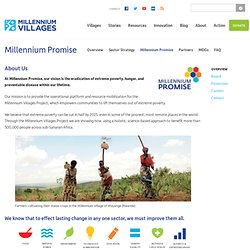
Our mission is to provide the operational platform and resource mobilization for the Millennium Villages Project, which empowers communities to lift themselves out of extreme poverty. We believe that extreme poverty can be cut in half by 2015, even in some of the poorest, most remote places in the world. Through the Millennium Villages Project we are showing how, using a holistic, science-based approach to benefit more than 500,000 people across sub-Saharan Africa. Farmers cultivating their maize crops in the Millennium Village of Mayange (Rwanda). We know that to effect lasting change in any one sector, we must improve them all. Millennium Villages throughout Africa are showcasing… how effective an integrated strategy for health care, education, agriculture, and small business can be.
Our Approach Learn more about the Millennium Villages approach > Our Team.
Sustainable agriculture. Sustainable agriculture is the act of farming using principles of ecology, the study of relationships between organisms and their environment.
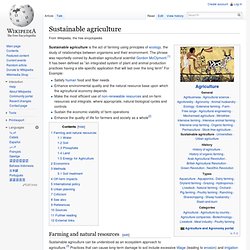
The phrase was reportedly coined by Australian agricultural scientist Gordon McClymont.[1] It has been defined as "an integrated system of plant and animal production practices having a site-specific application that will last over the long term" For Example: Satisfy human food and fiber needsEnhance environmental quality and the natural resource base upon which the agricultural economy dependsMake the most efficient use of non-renewable resources and on-farm resources and integrate, where appropriate, natural biological cycles and controlsSustain the economic viability of farm operationsEnhance the quality of life for farmers and society as a whole[2] Community Food Systems and Sustainable Agriculture Program. UC Sustainable Agriculture Research and Education Program. The Seed Ambassadors Project. Organic Agriculture Centre of Canada (OACC) homepage. Organic agriculture and the global food supply.
Permaculture. With its system of applied education, research and citizen- led design permaculture has grown a popular web of global networks and developed into a global social movement[citation needed].
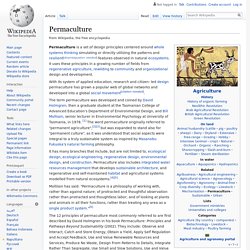
The term permaculture was developed and coined by David Holmgren, then a graduate student at the Tasmanian College of Advanced Education's Department of Environmental Design, and Bill Mollison, senior lecturer in Environmental Psychology at University of Tasmania, in 1978. [1] The word permaculture originally referred to "permanent agriculture",[3] but was expanded to stand also for "permanent culture", as it was understood that social aspects were integral to a truly sustainable system as inspired by Masanobu Fukuoka’s natural farming philosophy. Agriculture Library Index. Sustainability, Green, Permaculture, and Community Resources. Permaculture & Gardening.
Masanobu Fukuoka's Natural Farming and Permaculture. Masanobu Fukuoka is a farmer/philosopher who lives on the Island of Shikoku, in southern Japan.
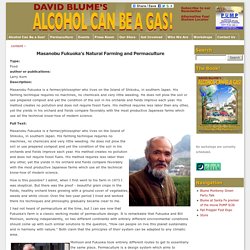
His farming technique requires no machines, no chemicals and very little weeding. He does not plow the soil or use prepared compost and yet the condition of the soil in his orchards and fields improve each year. His method creates no pollution and does not require fossil fuels. His method requires less labor than any other, yet the yields in his orchard and fields compare favorably with the most productive Japanese farms which use all the technical know-how of modern science. How is this possible? I had not heard of permaculture at the time, but I can see now that Fukuoka's farm is a classic working model of permaculture design. Mollison and Fukuoka took entirely different routes to get to essentially the same place. The key word here is design. The idea for natural farming came to Fukuoka when he was about twenty five years old.
But where to begin? Zone 2 is his grain fields. Larry Korn P.O. Masanobu Fukuoka. Masanobu Fukuoka (福岡 正信?)
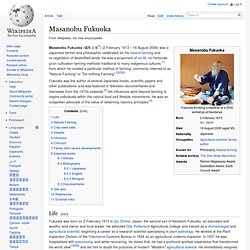
(2 February 1913 – 16 August 2008) was a Japanese farmer and philosopher celebrated for his natural farming and re-vegetation of desertified lands. He was a proponent of no-till, no-herbicide grain cultivation farming methods traditional to many indigenous cultures,[1] from which he created a particular method of farming, commonly referred to as "Natural Farming" or "Do-nothing Farming".[2][3][4] Fukuoka was the author of several Japanese books, scientific papers and other publications, and was featured in television documentaries and interviews from the 1970s onwards.[5] His influences went beyond farming to inspire individuals within the natural food and lifestyle movements.
He was an outspoken advocate of the value of observing nature's principles.[6] Life[edit] David Holmgren. David Holmgren (born 1955) is an Australian environmental designer, ecological educator and writer.
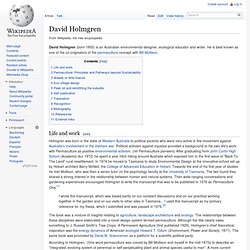
He is best known as one of the co-originators of the permaculture concept with Bill Mollison. Life and work[edit] Holmgren was born in the state of Western Australia to political parents who were very active in the movement against Australia's involvement in the Vietnam war. Bill Mollison. Bruce Charles 'Bill' Mollison (born 1928 in Stanley, Tasmania, Australia) is a researcher, author, scientist, teacher and Biologist.
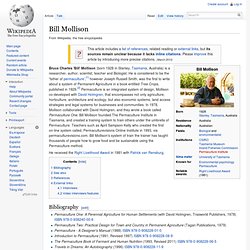
He is considered to be the 'father of permaculture',[1] however Joseph Russell Smith, was the first to write about a system of Permanent Agriculture in a book entitled Tree Crops, published in 1929.[2] Permaculture is an integrated system of design, Mollison co-developed with David Holmgren, that encompasses not only agriculture, horticulture, architecture and ecology, but also economic systems, land access strategies and legal systems for businesses and communities.
In 1978, Mollison collaborated with David Holmgren, and they wrote a book called Permaculture One. Bill Mollison founded The Permaculture Institute in Tasmania, and created a training system to train others under the umbrella of Permaculture. He received the Right Livelihood Award in 1981 with Patrick van Rensburg. Bibliography[edit] Bill Mollison - 1 - El Problema.
Bill Mollison - 2 - La Idea. Bill Mollison - 3 - Ecologia del Bosque. Bill Mollison - 4 - Diseño Permacultural. Bill Mollison - 5 - Las Aves de Corral. Bill Mollison - 6 - Huerta en Casa vs Costos de Distribucion. Bill Mollison - 10 - Proyectos de Permacultura. Bill Mollison - 11 - Invertir en Permacultivo. Bill Mollison - 12 - Funcionara el Permacultivo? Bill Mollison - Permaculture Design. ...Bill Mollison Permacultura... ...O...